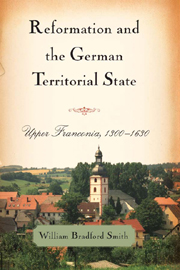
- Publisher:
- Boydell & Brewer
- Online publication date:
- September 2012
- Print publication year:
- 2008
- Online ISBN:
- 9781580467490
- Subjects:
- Area Studies, European History 1000-1450, History, European Studies
Last updated 09/07/24: Online ordering is currently unavailable due to technical issues. We apologise for any delays responding to customers while we resolve this. For further updates please visit our website: https://www.cambridge.org/news-and-insights/technical-incident


Religious reform and the rise of the territorial state were the central features of early modern German history. Reformation and state-building, however, had a much longer history, beginning in the later Middle Ages and continuing through the early modern period. In this insightful new study, Smith explores the key relationship between the rise of the territorial state and religious upheavals of the age, centering his investigation on the diocese of Bamberg in upper Franconia. During the Reformation, the diocese was split in half: the parishes in the domains of the Franconian Hohenzollerns became Lutheran; those under the secular jurisdiction of the bishops of Bamberg remained Catholic. Drawing from a broad range of archival sources, Smith offers a compelling look at the origins and course of Catholic and Protestant reform. He examines the major religious crises of the period - the Great Schism, the Conciliar Movement, the Hussite War, the Peasant's War, the Thirty Years' War, and the Witch Craze - comparing their impact on the two states and showing how events played out on the local, territorial, and imperial stages. Careful analysis of the sources reveals how religious beliefs shaped politics in the emerging territorial principalities, explaining both the similarities as well as the profound differences between Lutheran and Catholic conceptions of the state. William Bradford Smith is professor of history at Oglethorpe University.
Reformation and the German Territorial State is an impressive volume. . . . Smith's renderings of numerous archival cases are keenly attuned to actual indindividuals, vivid communities, and shifting institutions, which he presents with clarity, precision, and winsome detail.'
J. Jeffery Tyler Source: Renissance Quarterly
Ambitiously conceived and meticulously researched, this book sets out to examine the twin processes of religious reform and territorial formation. What distinguishes this work is its dual perspective and its nuanced approach to the complexity of change and the thoughts behind the process. . . . As the book illustrates, the reform of religion could act as a buttress to the making of the territory, but it could threaten its stability as well. Few recent works on German Reformation have captured this sense of contingency as skillfully as Reformation and the German Territorial State.'
C. Scott Dixon Source: Journal of Ecclesiastical History
Smith skillfully combines a variety of archival, primary, and secondary sources. . . . His analysis is of broader temporal scope than most of the scarce work on Upper Franconia in English; the results, though occasionally counterintuitive, will be of strong comparative value. The book's mature, sophisticated narrative reveals the author's eye for the telling detail. Summing Up: Highly recommended. Upper-division undergraduates and above.'
Source: Choice
 Loading metrics...
Loading metrics...
* Views captured on Cambridge Core between #date#. This data will be updated every 24 hours.
Usage data cannot currently be displayed.